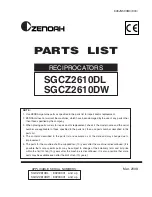
31
Operation
Always check the blade being fitted is suitable for the material being
cut.
Only fit blades that are in perfect condition. Blunt, bent, and cracked
blades should be discarded.
1. Press in the spindle lock button (28) and carefully rotate the blade by
pushing on the side face of the saw blade until the spindle lock
engages. Unscrew the blade securing bolt (16) clockwise using the
supplied hex key.
2. Remove the blade securing bolt, washer (if fitted) and blade flange
(17).
3. Use the lower guard lever (27) to rotate the lower guard (15) out of
the way.
4. Fit the required blade, making sure the direction indicator (14) on the
face of the blade is in the same direction as the direction indicator
(26).
5. Re-fit the blade flange, washer and blade securing bolt. Press in the
spindle lock button and tighten using the hex key.
6. Ensure the blade is secure before use.
Setting Bevel Angle
This saw is equipped with a tilting base plate (14). This allows bevel
cuts to be made.
1. Alter the angle of the base plate by loosening the bevel angle
locking knob (22). The base plate will now be free to pivot.
2. Select the angle required (0° - 45°) using the bevel angle gauge (23)
and retighten the bevel angle locking knob.
3. Ensure accuracy by checking the angle between the blade (13) and
the base plate using a suitable protractor.
Setting Depth Adjustment
This saw is equipped with a depth adjustment mechanism.
1. Alter the depth of the cut by loosening the depth locking knob (12).
The base plate (14) is now free to adjust to the required depth.
2. Adjust the base plate to the required depth using the depth scale
(11) or a ruler and retighten the depth locking knob.
3. When set correctly, the blade teeth should project approximately
3 mm from the underside of the material being cut.
















































